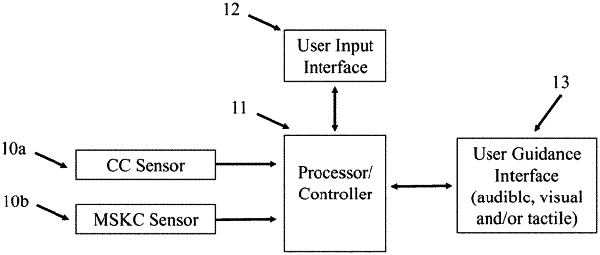| CPC A63B 71/06 (2013.01) [A61B 5/024 (2013.01); A61B 5/0205 (2013.01); A61B 5/026 (2013.01); A61B 5/1118 (2013.01); A61B 5/352 (2021.01); A61B 5/486 (2013.01); A63B 24/0062 (2013.01); A63B 24/0075 (2013.01); A63B 24/0087 (2013.01); A63B 71/0686 (2013.01); G09B 19/00 (2013.01); G09B 19/0038 (2013.01); G09B 23/288 (2013.01); G16H 20/30 (2018.01); G16H 50/30 (2018.01); A61H 1/0255 (2013.01); A61H 1/0274 (2013.01); A61H 3/00 (2013.01); A61H 2201/1633 (2013.01); A61H 2201/1642 (2013.01); A61H 2201/5015 (2013.01); A61H 2201/5064 (2013.01); A61H 2201/5071 (2013.01); A61H 2201/5084 (2013.01); A61H 2201/5092 (2013.01); A61H 2201/5097 (2013.01); A61H 2230/045 (2013.01); A61H 2230/065 (2013.01); A61H 2230/208 (2013.01); A61H 2230/305 (2013.01); A61H 2230/42 (2013.01); A61H 2230/50 (2013.01); A61H 2230/60 (2013.01); A61H 2230/805 (2013.01); A63B 15/00 (2013.01); A63B 21/002 (2013.01); A63B 21/0023 (2013.01); A63B 21/06 (2013.01); A63B 22/0023 (2013.01); A63B 22/0056 (2013.01); A63B 22/0076 (2013.01); A63B 22/0235 (2013.01); A63B 22/0605 (2013.01); A63B 22/0664 (2013.01); A63B 23/1218 (2013.01); A63B 23/1236 (2013.01); A63B 69/0028 (2013.01); A63B 2024/0093 (2013.01); A63B 2024/0096 (2013.01); A63B 2071/0625 (2013.01); A63B 2071/0655 (2013.01); A63B 2071/0663 (2013.01); A63B 2220/10 (2013.01); A63B 2220/17 (2013.01); A63B 2220/30 (2013.01); A63B 2220/40 (2013.01); A63B 2220/56 (2013.01); A63B 2220/62 (2013.01); A63B 2220/805 (2013.01); A63B 2220/806 (2013.01); A63B 2220/833 (2013.01); A63B 2220/836 (2013.01); A63B 2220/89 (2013.01); A63B 2225/50 (2013.01); A63B 2225/54 (2013.01); A63B 2230/045 (2013.01); A63B 2230/062 (2013.01); A63B 2230/207 (2013.01); A63B 2230/425 (2013.01); A63B 2230/50 (2013.01); A63B 2230/60 (2013.01); A63B 2230/75 (2013.01); A63B 2244/20 (2013.01)] | 20 Claims |

|
1. A computer-implemented method of guiding a user to achieve musculoskeletal pulsation, the computer-implemented method, configured to be executed by one or more processors, comprising:
receiving a cardiovascular cycle signal from a first sensor;
determining a heart rate of the user based on at least a portion of the cardiovascular cycle signal;
receiving a rhythmic musculoskeletal activity timing signal from a second sensor;
determining an actual musculoskeletal activity cycle (MSKC) to cardiovascular cycle (CC) timing relationship based on the cardiovascular cycle signal and the rhythmic musculoskeletal activity timing signal;
comparing the actual MSKC to CC timing relationship to a target MSKC to CC timing relationship;
providing a recurrent prompt to the user as a timing indication for performance of a rhythmic musculoskeletal activity to guide the user to achieve a musculoskeletal activity cycle rate (MSKR) that approaches the target MSKC to CC timing relationship; and
altering a feature of the recurrent prompt based on a determined alignment between the actual MSKC to CC timing relationship and the target MSKC to CC timing relationship.
|